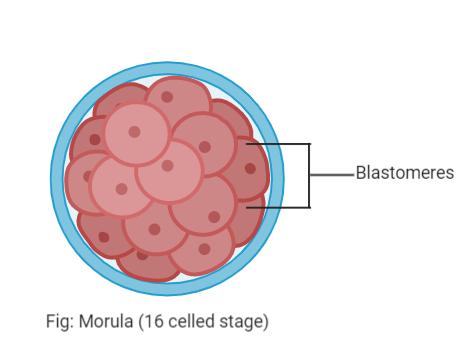
Which one of the following statements about morula in humans is correct?
A. It has far less cytoplasm as well as less DNA than in an uncleaved zygote.
B. It has a more or less equal quantity of cytoplasm and DNA as in uncleaved zygote.
C. It has more cytoplasm and more DNA than an uncleaved zygote.
D. It has an almost equal quantity of cytoplasm as an uncleaved zygote but much more DNA.
Answer
555.3k+ views
Hint: A morula is an early-stage embryo composed of 16 cells in a solid ball located within the Zona Pellucida. A zygote is formed by the fusion of the male gamete and the female gamete during fertilization. It has a high genetic content at this stage.
Complete answer: The zygote undergoes cleavage after fertilization, forming 2-celled embryos first. After which, all of these cells are subjected to mitosis and divisions, taking the cell count to 4. Repeated divisions boost the number of cells that make up the embryo, or blastomeres. The embryo is a dense ball of blastomeres called a morula at about the 32-cell level. Due to rapid cleavage divisions, a morula would have about the same amount of cytoplasm as the zygote, but a greatly increased amount of DNA.

Cleavage refers to the rapid cell divisions that turn a single-celled zygote into a multicellular structure. The daughter cells formed by zygote cleavage are referred to as blastomeres. The first zygote cleavage creates two cells that then split to form four cells, and so on. A morula is known as the 16-celled embryonic stage. The rapid division of cells during zygote cleavage is not followed by an increase in cell mass. This would be due to the short interphase resulting in a decrease in the size of blastomeres as the total cytoplasmic mass remains close to that of a zygote with increasing numbers. Therefore, the morula has about the same cytoplasmic weight as the zygote. Each cleavage division is accompanied by DNA replication with an equal allocation of doubled DNA to daughter cells. Each cell division, thus, doubles the morula's DNA content.
Hence, the correct answer is option D.
Note: The placenta serves as a membrane between the mother and the foetus. The placenta functions as an ultrafilter, whereby soluble nutrients, minerals, hormones, antibodies, will move over it and move into the fetus, even though the blood of the foetus and mother does not combine or blend. Also, it helps to share gases between the two and to remove the fetus from nitrogen waste.
Complete answer: The zygote undergoes cleavage after fertilization, forming 2-celled embryos first. After which, all of these cells are subjected to mitosis and divisions, taking the cell count to 4. Repeated divisions boost the number of cells that make up the embryo, or blastomeres. The embryo is a dense ball of blastomeres called a morula at about the 32-cell level. Due to rapid cleavage divisions, a morula would have about the same amount of cytoplasm as the zygote, but a greatly increased amount of DNA.

Cleavage refers to the rapid cell divisions that turn a single-celled zygote into a multicellular structure. The daughter cells formed by zygote cleavage are referred to as blastomeres. The first zygote cleavage creates two cells that then split to form four cells, and so on. A morula is known as the 16-celled embryonic stage. The rapid division of cells during zygote cleavage is not followed by an increase in cell mass. This would be due to the short interphase resulting in a decrease in the size of blastomeres as the total cytoplasmic mass remains close to that of a zygote with increasing numbers. Therefore, the morula has about the same cytoplasmic weight as the zygote. Each cleavage division is accompanied by DNA replication with an equal allocation of doubled DNA to daughter cells. Each cell division, thus, doubles the morula's DNA content.
Hence, the correct answer is option D.
Note: The placenta serves as a membrane between the mother and the foetus. The placenta functions as an ultrafilter, whereby soluble nutrients, minerals, hormones, antibodies, will move over it and move into the fetus, even though the blood of the foetus and mother does not combine or blend. Also, it helps to share gases between the two and to remove the fetus from nitrogen waste.
Recently Updated Pages
Master Class 12 English: Engaging Questions & Answers for Success

Master Class 12 Economics: Engaging Questions & Answers for Success

Master Class 12 Social Science: Engaging Questions & Answers for Success

Master Class 12 Maths: Engaging Questions & Answers for Success

Master Class 12 Chemistry: Engaging Questions & Answers for Success

Master Class 12 Business Studies: Engaging Questions & Answers for Success

Trending doubts
What are the major means of transport Explain each class 12 social science CBSE

Which are the Top 10 Largest Countries of the World?

Draw a labelled sketch of the human eye class 12 physics CBSE

Explain sex determination in humans with line diag class 12 biology CBSE

The pH of the pancreatic juice is A 64 B 86 C 120 D class 12 biology CBSE

Explain sex determination in humans with the help of class 12 biology CBSE




